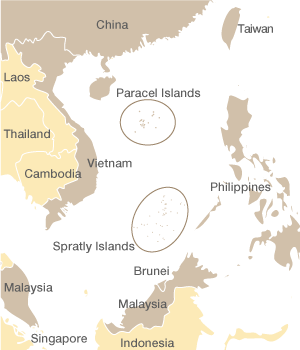
Abe’s Mandate; China’s Face-off with ASEAN
Politics- English
- 日本語
- 简体字
- 繁體字
- Français
- Español
- العربية
- Русский
The Upper House Election: End of the “Twisted” Diet
The election on July 21 for the House of Councillors resulted in a major victory for the Liberal Democratic Party and its coalition partner, the New Kōmeitō. The two ruling parties together won 76 of the 121 contested seats, giving them a solid majority in the upper house (they already hold more than two-thirds of the seats in the House of Representatives).(*1) The LDP won in 29 of the 31 single-member districts (the only exceptions being in Okinawa and Iwate). In total, it garnered 65 seats, and the Kōmeitō came away with 11. The two parties also have 59 upper house seats that were not up for election this time, giving them a total of 135 in the 242-seat chamber, up 32 from their preelection figure of 103. They secured not just a simple majority of over 122 but what is called a “stable” majority of over 129, meaning that they can monopolize the chairs of all the standing committees. This marked the end of an extended period in which the ruling coalition held a majority in the lower house but was in the minority in the upper house, a situation called nejire, or “twisting,” in Japanese.
The Democratic Party of Japan, the LDP’s main rival, went down to a crushing defeat. It failed to win any seats in the 19 single-member districts where it fielded candidates, and it managed to hold on to only 17 out of the 44 of its seats that were up for election this time. It was the party’s weakest performance in an upper house election since its foundation in 1998. Two newer opposition parties that had been attracting attention, Your Party and the Japan Restoration Party, won 8 seats each, which may be considered a disappointing outcome for them. Meanwhile, the Japanese Communist Party won seats in the electoral districts of Tokyo, Kyoto, and Osaka. It was the first time since 2001 that the JCP came out of an upper house election with seats from the district voting.(*2)
Voter turnout was 52.6% (as measured by the electoral district vote), down from the 57.9% figure for the previous upper house election in 2010. The expectation of a major victory for the ruling coalition was probably a factor.
Public Hopes for Decisive Politics and a Strong Economy
At a press conference at the LDP headquarters on July 22, the day after the election, Prime Minister Abe Shinzō delivered an opening statement that included the following remarks:
We’ve been steadily achieving results, and indicators like gross domestic product and employment have changed for the better. Yesterday I sense that we got a strong push from the people to continue without wavering on this path by conducting decisive politics. . . .If we return to the old LDP, neglecting dialogue with the public and shirking reform, we’ll immediately lose the people’s trust in our party. . . .Today marks our real start. What the people want most is the restoration of a strong economy that can be felt in every part of the country. The economy is the wellspring of national power. Diplomatic strength and a stable social security system aren’t possible without [a strong] economy. . . .The extraordinary Diet session this autumn will be a session focused on implementation of our growth strategy. We hope to decide on a bold cut in taxes on investment and secure passage of legislation to strengthen industrial competitiveness. Without implementation [of our strategy], there will be no growth. We will move with alacrity to implement the policies contained in our Japan Revitalization Strategy. . . .Bold regulatory reform, the TPP [Trans-Pacific Partnership] negotiations, and the hiking of the consumption tax are all difficult issues, but we must come up with conclusions for the sake of the future.
The prime minister is quite right. According to a postelection poll by newspaper publisher Nikkei Inc. conducted on July 22–23, 62% of respondents were pleased at the end of the twisted Diet, and 61% favored the idea of focusing on policy implementation over the coming three years without calling another election for the lower house in the interim.(*3) And those who approved the Abe administration’s economic policies (“Abenomics”) outnumbered those who did not by 56% to 29%. In sum, the public, whose votes gave the ruling coalition control of the upper house, is hoping that the administration will now focus on restoring Japan’s economic strength.
The government is reportedly now considering a number of specific regulatory reforms, including the relaxation of employment regulations (such as provisions for overtime, dismissal, and limited-term employment contracts) inside “national strategic special zones”; expanded admission of foreign nurses and other professional care providers; permission for ordinary business corporations to own farmland; and lifting of the requirement that commercial buildings provide parking space. I hope that Prime Minister Abe will show leadership in pushing ahead with more and even bolder deregulatory moves in fields like healthcare and agriculture within the special zones.
China and ASEAN: Face-off in the South China Sea
From June 27 through July 2 Brunei hosted a meeting of the foreign ministers of the Association of Southeast Asian Nations, along with gatherings of the ASEAN Regional Forum, the East Asian Summit foreign ministers’ meeting, and other meetings with ASEAN’s dialogue partners. At the ASEAN-China foreign ministers’ meeting on June 30, it was agreed to start negotiations this September on a legally binding Code of Conduct in the South China Sea. When the ASEAN foreign ministers met in Phnom Penh in July last year, they were divided on the matter of the South China Sea, where China has been pressing its claims to islands also claimed by ASEAN members, notably the Philippines and Vietnam. And as a result of their disagreement, the assembled ministers were unable to issue a joint communiqué for the first time in the history of these ASEAN meetings. The outcome of this year’s meetings in Brunei represents a major advance over last year’s.(*4)
That does not mean, however, that the issues of the South China Sea are headed toward resolution. China has not changed its basic stance of opposing the “internationalization” (multilateral treatment) of these issues; it wants them to be handled bilaterally between itself and the individual countries concerned. Last year, after an extended face-off between patrol vessels from China and the Philippines in the waters around Scarborough Shoal, which both countries claim, the Chinese established effective control; Manila has called for the issue to be resolved by an international court of arbitration, but Beijing has refused to accept this proposal. More recently, Chinese surveillance vessels have stationed themselves in the waters of the Second Thomas Shoal in the Spratly Islands, which is effectively controlled by the Philippines, and just before the recent ASEAN-China foreign ministers’ meeting the Chinese demanded that the Philippines halt its “acts violating China’s sovereignty” in these waters.
 A
A
lso, just after the ASEAN-China foreign ministers’ meeting, the Chinese government (State Council) approved the rules concerning the revamping of the organs and personnel of its State Oceanic Administration, calling on the SOA to enhance its capabilities for executing laws so as to protect China’s maritime rights and to defend maritime order and rights. And July 22 brought the launch of a new Maritime Police Bureau equipped with armed vessels for law enforcement in waters including the East China Sea and South China Sea.
In view of this situation, even though the Chinese have agreed to the launch of talks on a Code of Conduct in the South China, it seems unlikely that Beijing will move promptly or speedily on this front. China’s strategy will probably be to make these talks drag on and act in the meantime to conduct “law enforcement” in the areas that it claims so as to build up its track record of effective control over disputed islands and waters in the South China Sea. In recent years there has been a sharp increase in the number of cases of Chinese government vessels seizing Vietnamese and Philippine fishing ships around the Paracels and Spratlys and interfering with the activities of vessels exploring for seabed resources. According to Manila, whereas there were only seven cases of Chinese obstruction in the waters of the Spratlys from 1995 through 2009, the number of cases jumped to 24 in the years from 2010 to 2012.
As China’s Maritime Police Bureau gets into full swing, it is likely that trouble with Vietnam and the Philippines will increase and that the situation in the South China Sea will grow even more tense.
(Originally written in Japanese on July 29, 2013.)
(*1) ^ The 242 members of the House of Councillors are elected to six-year terms; once every three years an election is held for half of the seats.—Ed.
(*2) ^ In each upper house election, 73 members are elected from 47 electoral districts (each prefecture being a district), and 48 members are chosen by nationwide proportional representation balloting. —Ed.
(*3) ^ The next upper house election will be in the summer of 2016. The prime minister can call a general election for the lower house at any time but will not have to do so (except in the unlikely case of passage of a no-confidence motion) until December 2016, when the four-year term of the current lower house members expires. —Ed.
(*4) ^ See these articles for related information:
Shiraishi Takashi, “China’s Diplomatic Offensive: Consequences for Regional Relations,” August 2012.
Yamakage Susumu, “ASEAN’s Positive Record and Ambitious Plans,” November 2012.
Tsuruta Jun, “Conflicts and Disputes over Maritime Interests in East Asian Seas: The Role of Maritime Law Enforcement Agencies,” December 2012.
diplomacy Shiraishi Takashi China politics ASEAN economy DPJ LDP South China Sea New Kōmeitō JCP Your Party House of Councillors JRP